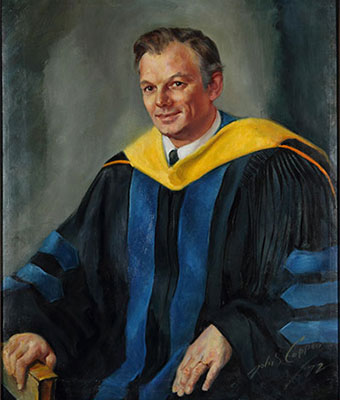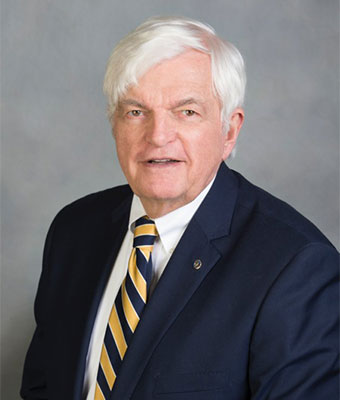
A new book by former faculty member Dr. Douglas Neckers celebrates Hope’s eighth president, Dr. Calvin VanderWerf, for enabling the college not only to survive in the research-focused era of Sputnik, but to become the nationally recognized institution which continues to thrive today.
 Neckers’s book “Cal VanderWerf: Anchor of Hope” credits VanderWerf, who led the college
from 1963 to 1970, with transforming Hope into an institution that provided an exceptional
education for students of the space age and years since. Published in June by BioSolar
Publishing, the book explores how VanderWerf, who had a distinguished career in higher
education as a chemist before becoming Hope’s eighth president, emphasized enhancing
the college’s academic quality, particularly in the physical sciences. It was a move,
Neckers notes, that was absolutely essential as private colleges and state-supported
universities began to compete ever more not only for students but also external funding
for their programs—especially for research—resources that were and continue to be
crucial.
Neckers’s book “Cal VanderWerf: Anchor of Hope” credits VanderWerf, who led the college
from 1963 to 1970, with transforming Hope into an institution that provided an exceptional
education for students of the space age and years since. Published in June by BioSolar
Publishing, the book explores how VanderWerf, who had a distinguished career in higher
education as a chemist before becoming Hope’s eighth president, emphasized enhancing
the college’s academic quality, particularly in the physical sciences. It was a move,
Neckers notes, that was absolutely essential as private colleges and state-supported
universities began to compete ever more not only for students but also external funding
for their programs—especially for research—resources that were and continue to be
crucial.
“Cal’s presidency built Hope College into a place where it would not just survive, but lead in intellectual experiences for American undergraduates in the final decades of the 20th century,” Neckers writes in the book.
VanderWerf was a 1937 Hope graduate who previously had been a member of the faculty at the University of Kansas, where he had been a professor and later chair of the chemistry department (1941-63) and had conducted an active research program. “He was a leader in his field and he chose to return to his alma mater to give something back,” Neckers said.
Neckers, who is a 1960 Hope graduate, lived most of the VanderWerf era himself as a young member of the Hope chemistry faculty from 1964 to 1971. From teaching and conducting research with students at Hope, Neckers went on first to the University of New Mexico and then to Bowling Green University, where he founded the Center for Photochemical Sciences and in 2009 retired as the McMaster Distinguished Research Professor. He currently serves as chief executive officer and founder of Spectra Group, a photochemical sciences company specializing in materials for three-dimensional printing. Hope presented him with a Distinguished Alumni Award in 2015.
Neckers acknowledges that the seeds of Hope’s modern trajectory were planted before VanderWerf arrived—as VanderWerf himself made a point of saying in his 1963 inaugural address. It was in the 1940s during the presidency of Dr. Irwin Lubbers, for example, that chemist Dr. Gerrit Van Zyl first involved students collaboratively in research, the beginning of the teaching model for which Hope continues to be nationally known. The emphasis on academic excellence, scholarship and active learning has also continued in the years which have followed, under the presidential leadership of Dr. Gordon Van Wylen (1972-87), Dr. John Jacobson (1987-99), Dr. James Bultman (1999-2013) and Dr. John Knapp (2013- ).
It was during the VanderWerf years, though, that such active engagement in scholarship became a particular focus at the college, according to Neckers.
“During his presidency, from 1963 to 1970, Hope transitioned from a college-centric institution into the more common department-centric school of postwar America,” Neckers said. “He added faculty in every field Hope knew to build a very energetic ‘Cal’s Hope.’ Young faculty, most of whom had earned the highest advanced degree in their field, took their specializations more seriously than they did the college identity. So Hope emerged from the small institution that had survived the Depression and a World War as a college with enormous academic strength among four-year colleges.”
Although presented more than 50 years ago, VanderWerf’s inaugural remarks continue to resonate: “We must continue to offer, under terms which students can afford, a liberal arts education of distinction and excellence, to the able, and to the ordinary, who come to us from this community, from this state, from this country, and from the far reaches of the world,” he said. Also, he observed, “Study abroad may soon be considered an essential component of a truly liberal education,” and “we must, increasingly, I believe, devise courses and majors that obliterate departmental lines.” Speaking to Hope’s identity and role specifically, VanderWerf noted, “And the Christian liberal arts college, by its very existence, asserts for all times, and we believe particularly for these times, that education which addresses itself simply to the intellect is not enough, that we as teachers must be concerned ‘not only with where our students’ heads are, but also where their hearts are.’”
Hope began receiving major funding for its science programs during VanderWerf’s presidency, beginning with a $375,000 award from the Alfred P. Sloan Foundation in 1967—at the time the largest external award the college had received. An energetic building program during the VanderWerf era included construction of the DeWitt Student and Cultural Center, the Peale Science Center (today part of the A. Paul Schaap Science Center), an addition to the former Nykerk Hall of Music and two residence halls. Enrollment during his tenure increased approximately 30 percent to 2,060 students, while the number of faculty grew from 82 to 147.
While the VanderWerf presidency had a lasting positive impact on Hope, Neckers noted that his years at the college were also difficult. There were those at Hope and in its constituency, Neckers said, who resisted the changes. It was also a turbulent era in the United States and at college and universities as the nation wrestled with war, race, generational conflict and political uncertainty. VanderWerf’s health, he said, suffered, and he was hospitalized with double pneumonia in February 1970. His resigned later that year.
A year after leaving Hope, VanderWerf became dean of the College of Arts and Sciences at the University of Florida in Gainesville, where he was also a member of the chemistry faculty. He died on July 18, 1988, at age 71.
Hope renamed its Physics Mathematics Hall, completed in 1964, in VanderWerf’s honor in 1981, but Neckers hopes that his book serves as a lasting tribute to VanderWerf’s enduring impact and selfless leadership.
“He had a distinguished academic career; he didn’t have to take the job,” Neckers said. “He was a sought-after scientist-administrator. He’d paid his dues in the academy of scholars and his presidential directives were from the academician’s perspective. He took the job because he believed in Hope’s mission.”
The Hope of 2016, he feels, is also the eighth president’s monument.
“Cal came to work at his historic college and ended up inventing its 21st century future,” Neckers writes. “Hope College, today, advertises that it offers graduate level instruction in a current sense to undergraduate students. And it does so in the liberal arts, Christian setting.”
“America needs what Hope says it offers,” he writes. “It is a joy to see that its research strengths, even though they are accomplished with just undergraduates, are the best in the United States. To its future, and to a future that remains sprinkled with Cal VanderWerf’s legacy, goes all of the best in the world.”
“Cal VanderWerf: Anchor of Hope” totals 481 pages, and includes more than 100 pages of appendices among whose contents are VanderWerf’s inaugural address. The book is available for $29.95 through the college’s Hope-Geneva Bookstore. The bookstore is located on the ground level of the DeWitt Center, 141 E. 12th St., and can be called at 800-946-4673 or 616-395-7833. Additional ordering information may be obtained by e-mailing the Hope-Geneva Bookstore at bookstore@hope.edu.